CHICKBOX™
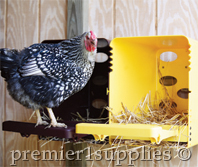
ChickBoxes™ can be used individually or as part of a multiple-unit system. Sturdy perch can hold even the heaviest of hens.
ChickBox™
1. Fold-up perch—Perch placement allows droppings to fall clear of nest area. Fold up perch to close the nest, keep broody hens out at night.
2. Perch upgrade—The perch now has added support struts to reduce the chance of it cracking or breaking.
3. Roll-out tray—Optional black roll-out tray slides into place. Speeds egg collection. Eggs stay clean (no droppings) because they roll away when the hen leaves, safe from pecking. (We use bedding for a week to train the hens, then remove it.)
4. Interlocking system—Multiple nest boxes snap together with interlocking side tabs. Separate the nests by doing the opposite. The bird’s weight is evenly distributed throughout the system, making it a secure unit for laying hens.
5. Plastic—safer. Unlike metal it won’t rust and has no sharp edges. And unlike wood there are no splinters and it doesn’t harbor mites. Easy to clean. All of it can be hosed down and washed with water and disinfectant. Entire assembly slides out and apart to provide full access for cleaning.
6. Choice of colors—Brown or yellow. Our birds do not seem to have a color preference.
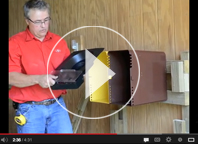
See the video above for ChickBox™assembly instructions.
COMING SOON
NEW PRODUCTS!
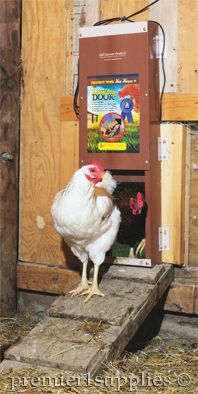
Are your hens up and ready earlier in the morning than you? The Poultry Door automatically opens in the morning to let the hens enjoy their day outside. Closes at night (dusk) to keep the coop shut and secure from predators.
New! Poultry Door
Predators are ever-present around poultry, and they can raise havoc and do serious damage in henhouses. For chicken coops small and large, the Poultry Door helps solve this problem, allowing birds to be outside during the day—even when you’re not around to open/close their door.
| • |
Door uses a daylight sensor to open at dawn and close at dusk—automatically. |
| • |
Raccoon-proof screw-drive design. |
| • |
No cables or jam-prone traction doors. |
| • |
Stops predators when closed. |
| • |
Easy installation. |
| • |
Self-tests, auto-reverses upon jamming or closing on a bird. |
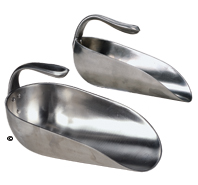
Two sizes of Aluminum TurboScoops for all sorts of jobs on the farm. Small scoop (2 lb capacity) is useful for refilling small bird and chicken feeders while the larger (4 lb) is suited for general farm use.
New! Aluminum TurboScoops
The best and last feed scoops we’ll ever buy. Front-facing ergonomic handle is uniquely easy to use and kind to wrists and forearms. Handle for hanging on gates/fences/feed bins. 2 or 4 lb capacities.
Note:
New poultry products will be added to our website as they're available. When available, these will be added to our new products tab.
Also look for Premier's new "Poultry Solutions Catalog" in your mailbox in January.
|
 |
 |
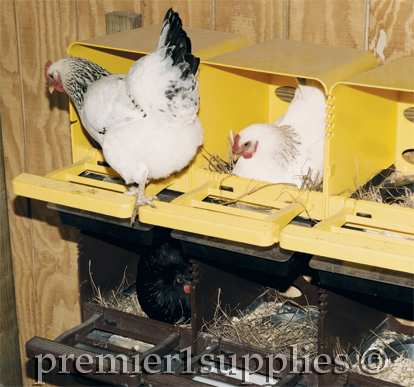
A Delaware hen being quite choosy about which ChickBox™ she wants to lay an egg in.
Winter Egg Production
Despite our best efforts, the weather's turning quite chilly as the light lingers less and less. Our birds have taken notice as well. In response to the lack of light, they believe they do not have to lay as many eggs.
But we have a way to circumvent mother nature. By keeping a light on in the coop an extra hour or two in the early morning and evening, the chickens will continue to lay eggs (albeit at a slower pace). So we will still have a source of fresh eggs, even through the winter. Once December 22 arrives, the daylight hours will start getting longer and we can look forward to more light (and eggs).
Below are a few articles from the University of Nebraska and Oregon State University that provide useful information on winter egg-laying and light management for poultry.
EXTENSION NEWS
Why Did My Chickens
Stop Laying?
By Dr. J. C. Hermes
Extension Poultry Specialist, Oregon State University
Egg production is a remarkable thing. A pullet (young female chicken) begins laying eggs at 18 to 20 weeks of age. She reaches peak production at about 35 weeks, with a production rate greater than 90 percent (that’s 9 eggs in 10 days for a single hen or 9 eggs from 10 birds daily). This period of peak production lasts about 10 weeks, after which her egg production slowly begins to decline.
A high-producing hen’s annual egg production is more than 10 times her body weight. The average commercial Single Comb White Leghorn hen lays about 265 eggs per year, with backyard breeds laying fewer. In most cases, the more exotic the breed, the poorer the egg production.
Hens stop laying eggs for a variety of reasons. External or internal stimuli affect hormone levels, which change the condition of the ovary and oviduct, the organs responsible for egg production. The result of these changes is the reduction or cessation of egg production. The most common stimuli that affect egg production are decreasing day length, disease, broodiness, poor nutrition, and stress. However, even under ideal conditions, every hen’s egg production eventually slows down and stops.
Read More »
EXTENSION NEWS
Proper Light Management for
Your Home Laying Flock
Published by Cooperative Extension, Institute of Agriculture and Natural Resources, University of Nebraska-Lincoln
by Chad Zadina, Extension Poultry Assistant AND Sheila E. Scheideler, Extension Poultry Specialist
Raising a home flock for the primary purpose of producing fresh eggs can be a rewarding and challenging venture. The main goal for egg producers is to ensure that their hens continue to produce eggs year-round. To accomplish this goal, one of the most important factors to consider, next to the overall health and nutrition of the flock, is lighting.
The avian reproductive cycle, which is how a hen produces eggs, is stimulated in poultry by increasing day length. As day length approaches 14 hours per day during early spring, chickens begin laying eggs, gradually increasing their production as the day length increases. They will reach their maximum egg laying potential when the day-light reaches approximately 16 hours per day.
Nature utilizes this characteristic so that chicks will hatch in the spring and have the warmer months of summer and fall to mature before the harsher winter season arrives. By providing artificial light, growers can manipulate this natural cycle to their advantage and increase the egg laying potential of their flocks.
Read More »
EXTENSION NEWS
Lighting for Small-Scale Flocks
Developed by Robert Hawes, Professor Emeritus of Animal and Veterinary Science, University of Maine.
Reviewed by Richard Brzozowski,
Extension Professor, University of Maine.
It is well known that light intensity and the length of the daily light period will influence growth rate and reproduction in poultry flocks. The first person credited with using a systematic lighting pattern for laying hens was E. C. Waldorf, a medical doctor from Buffalo, New York. The year was 1889, and Dr. Waldorf’s claim that his birds averaged ten eggs per week under artificial lights probably did much to create an interest in this new management technique. However, despite subsequent favorable reports from several agricultural experiment stations, it was nearly twenty years before the practice of lighting became commonplace.
About Bulbs and Fixtures
Although incandescent bulbs have long been used in lighting for poultry, there is an increasing use of fluorescent bulbs, just as in household use. When using fluorescent fixtures, choose “warm” wavelength bulbs, which emit more rays at the red-orange wavelength. The “cool” bulbs commonly used in homes and offices are less stimulating.
If you are depending on just one bulb, be sure to check it daily and replace it immediately if it should burn out. Keep in mind that the shadows cast by equipment, cages, and dropping boards will cut down on light efficiency. In addition, dusty bulbs can cause a real decrease in intensity.
Read More »
EXTENSION NEWS
Factors Affecting Egg Production in Backyard Chicken Flocks
By J.P. Jacob, H.R. Wilson, R.D. Miles,
G. D. Butcher, and F.B. Mather
University of Florida IFAS Extension
The laying cycle of a chicken flock usually covers a span of about 12 months. Egg production begins when the birds reach about 18-22 weeks of age, depending on the breed and season. Flock production rises sharply and reaches a peak of about 90%, 6-8 weeks later. Production then gradually declines to about 65% after 12 months of lay. A typical production curve for a laying flock, showing changes in the level of egg production and in egg weight, over time, is given in Figure 1 (see pdf below).
There are many factors that can adversely affect egg production. Unraveling the cause of a sudden drop in egg production requires a thorough investigation into the history of the flock. Egg production can be affected by such factors as feed consumption (quality and quantity), water intake, intensity and duration of light received, parasite infestation, disease, and numerous management and environmental factors.
Read More »
NEW PRODUCT
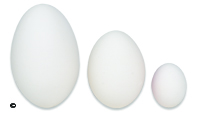
Trouble getting hens, geese or quail to lay where they are supposed to? Place an egg in their designated nesting area to encourage them to lay in the "right spot."
|
New! Ceramic Nest Eggs
For geese (3"), chickens (2.25") and quail (1.25"). White ceramic. Kiln-fired.
Q. What if the hens don’t lay in the nesting box?
A. Entice them into the box.
| • |
Try placing a ceramic (shown above) or wooden nest egg in the box. Many hens prefer a nest with other eggs in it. |
| • |
Place a comfortable amount of bedding in the nesting box (we like straw or similar bedding). |
| • |
Hens prefer to nest where they aren’t visible to predators. So it helps to locate nests in darker areas. |
|
|